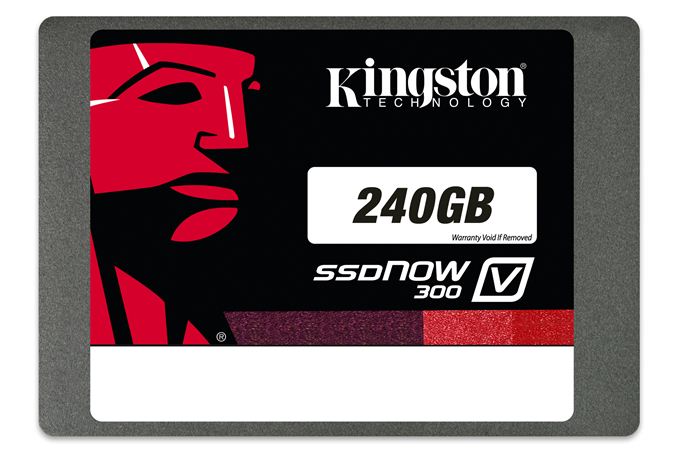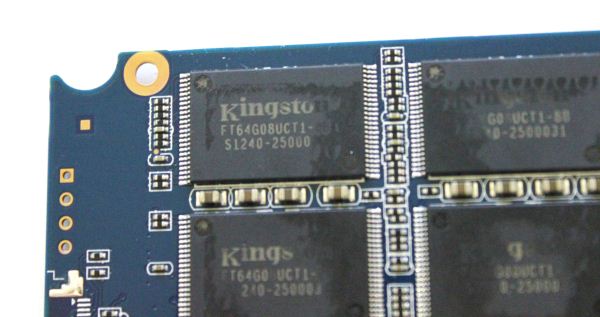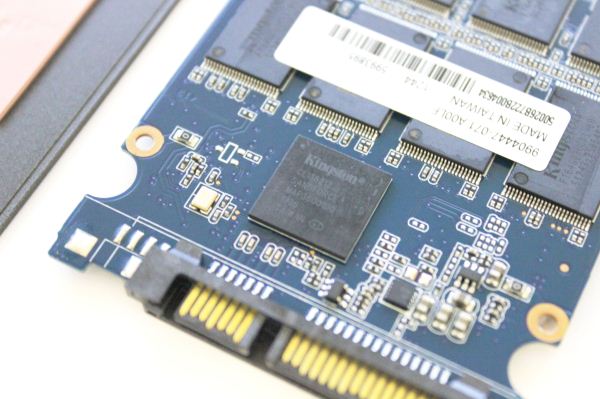Kingston SSDNow V300 (120GB & 240GB) Review
by Kristian Vättö on April 30, 2013 12:30 PM EST
Kingston's SSD lineup is as follows: They have HyperX-branded SSDs for enthusiasts and the mainstream market is catered by SSDNow brand. The HyperX SSDs have been fairly popular from what I've seen and we have also reviewed the regular HyperX as well as the 3K variant of it.
However, the SSDNow lineup has always been a big mess in my opinion. There's V-Series, V+ Series, V100, V+100, V200 and V+200 -- but there is very little consistency in the products. The V100 and V200 are both JMicron based, but the V+100 is Toshiba and the V+200 is SandForce based. And the new V300 is also SandForce based. Add to the mix that HyperX SSDs are SandForce too and the lineup couldn't really get any more confusing.
| Kington's Current SSD Lineup | |||
| SSDNow V+200 | SSDNow V300 | HyperX 3K | |
| Controller | SandForce SF-2281 | ||
| NAND | 25nm Intel asynchronous MLC | 19nm Toshiba (?) Toggle-Mode MLC | 25nm Intel synchronous MLC |
| Capacities (GB) | 60, 90, 120, 240, 480 | 60, 120, 240 | 90, 120, 240, 480 |
| Warranty | Three years | ||
Currently Kingston offers three SSDs with very little distinctiveness. I certainly hope that the V300 will simplify things and there won't be a V+300. The V+200 is still available (others are EOL) but I'm guessing it will be discontinued once Kingston has cleared their stocks. I don't have a problem with the SSDNow brand as a whole but I strongly dislike Kingston's naming system because the plus signs just don't make any sense. It would be okay if the plus sign stood for SandForce and the Vxxx was for example a budget Marvell-based drive, but currently the plus sign has no definite meaning. Considering Kingston has the HyperX lineup as well, I think the SSDNow should only consist of one model at a time to keep things neat and avoid product overlaps; then the V+xxx wouldn't have to exist anymore.
Product branding criticism aside, let's look at the actual V300:
| Kingston SSDNow V300 Specifications | |||
| Capacity | 60GB | 120GB | 240GB |
| Controller | SandForce SF-2281 | ||
| NAND | 19nm Toshiba (?) MLC NAND | ||
| Sequential Read | 450MB/s | 450MB/s | 450MB/s |
| Sequential Write | 450MB/s | 450MB/s | 450MB/s |
| 4KB Random Read | 85K IOPS | 85K IOPS | 85K IOPS |
| 4KB Random Write | 60K IOPS | 55K IOPS | 43K IOPS |
| Power Consumption | 0.640W (idle) - 2.052W (load) | ||
| Warranty | Three years | ||
There's a question mark after the NAND because Kingston only told us that the NAND is 19nm MLC. However, Toshiba-SanDisk join-venture is the only NAND manufacturer who uses 19nm process (IMFT is 20nm, Samsung 21nm and Hynix is still 26nm as far as I know), so there really aren't any other options. Similarly to many other OEMs, Kingston buys NAND in wafers and then does the validation and packaging on their own. The product numbers are also in-house and obviously there are no public datasheets, hence the info on the NAND is very limited.
Kingston branded NAND in the 120GB V300
Buying NAND seems to have become a trend among SSD OEMs lately. If you go back a year, everyone was using pre-packaged NAND but now at least OCZ, ADATA, Kingston and Transcend are buying NAND in wafers. I believe there's currently so much price competition (especially between SandForce OEMs) in the consumer SSD industry that costs need to be cut wherever possible. Buying NAND in wafers is cheaper because there are no binning or packaging costs involved and you also get a ton of lower quality NAND. It's actually a rather small percentage of the NAND wafer that's suitable for SSDs and the lower quality NAND usually gets used in devices where endurance isn't as critical (USB flash sticks, lower-end smartphones/tablets).
You might have noticed that most of the OEMs buying in wafers also make other NAND-based products. On the other hand, you also get the highest quality NAND dies that can be used in enterprise SSDs -- in the retail NAND market you would have to pay a hefty premium for those. The only concern I have is that SSD OEMs won't give us enough details about their NAND and its validation, which may result in lower quality NAND being used because the specifications are not public (for example Intel has always been very open about the endurance of their NAND, while Kingston wouldn't even tell us the original manufacturer). The price competition is very harsh and it can be tempting to use the lower quality NAND but I hope this is just my pondering and we won't see this happening.
Kingston touted that they worked very closely with SandForce/LSI to customize the SF-2281 platform for the V300. Now, even though the chip has Kingston's logo on it, it's the same SF-2281 that's available to everyone else. SandForce allows the client to customize the firmware by a certain degree but I don't know the exact level of customization that can be done (no straight access to the source code, though). I suspect the bigger the client, the more customization SandForce is willing to offer because the client is also able to put more resources into customization. I spoke with one of Kingston's SSD engineers and he said Kingston's firmware is not stock SandForce (like for example Corsair's is), but a custom one where they have tried to pick the best features from every firmware. What that really means in practice, I don't know, but let's see how it performs.
Test System
| CPU | Intel Core i5-2500K running at 3.3GHz (Turbo and EIST enabled) |
| Motherboard | AsRock Z68 Pro3 |
| Chipset | Intel Z68 |
| Chipset Drivers | Intel 9.1.1.1015 + Intel RST 10.2 |
| Memory | G.Skill RipjawsX DDR3-1600 2 x 4GB (9-9-9-24) |
| Video Card |
XFX AMD Radeon HD 6850 XXX (800MHz core clock; 4.2GHz GDDR5 effective) |
| Video Drivers | AMD Catalyst 10.1 |
| Desktop Resolution | 1920 x 1080 |
| OS | Windows 7 x64 |













43 Comments
View All Comments
eddieobscurant - Saturday, May 4, 2013 - link
I think kingston is using very low quality nand for the v300 series. The 128gb model only has 64tb tbw before reaches endurance limits and the 256gb only 128tb according to their official pdf datasheet. http://www.kingston.com/datasheets/sv300s3_us.pdf That would mean around 500 p/e. Samsung tlc drives have at least 1000 p/e. Could you please ask kingston about this?Kristian Vättö - Saturday, May 4, 2013 - link
That's most likely with a random write centric workload. E.g. Crucial M500 is rated at 72TB and Samsung SSD 840 Pro at 73TB, but the workloads for the figure mainly consist of small random writes. Let me send Kingston an email and ask about the exact workload so we'll know better.eddieobscurant - Saturday, May 4, 2013 - link
thanks, could you also ask if the warranty is voided if someone exceeds this limit?Diagrafeas - Monday, May 6, 2013 - link
Could you ask the about the firware updates, because 506 isn't working as it should.Could give the option to flash 505 or a fixed 507...
Kristian Vättö - Monday, May 6, 2013 - link
I'll ask about that too. Already sent an email about the endurance so I'll ask about the firmwares when Kingston replies.eddieobscurant - Tuesday, May 14, 2013 - link
Did you get any reply from kingston?Kristian Vättö - Friday, May 17, 2013 - link
I got a reply that they'll check and get back to me, but they haven't done that yet. You may want to drop me an email (kristian@anandtech.com) so I can reach to you directly when I receive an answer.Davidjan - Saturday, May 4, 2013 - link
Really cool! Storage will not be a problem on Android phones and tablets. Use this to add storage http://www.kickstarter.com/projects/andyfei/mini-m...Just check it out, last 15 hours to go to get it.
Davidjan - Saturday, May 4, 2013 - link
http://www.kickstarter.com/projects/andyfei/mini-m...spooky2th - Sunday, May 5, 2013 - link
I've had a Kingston 240GB HyperX 3K since Aug. 2012. And it is fantastic as far as I'm concerned. Even with Vista Home Premium, 64Bit. No trim support in Vista so I have to manually optimize the SSD every week or 2. Optimizing the SSD only takes a minute. Other than that, I am a very happy camper.